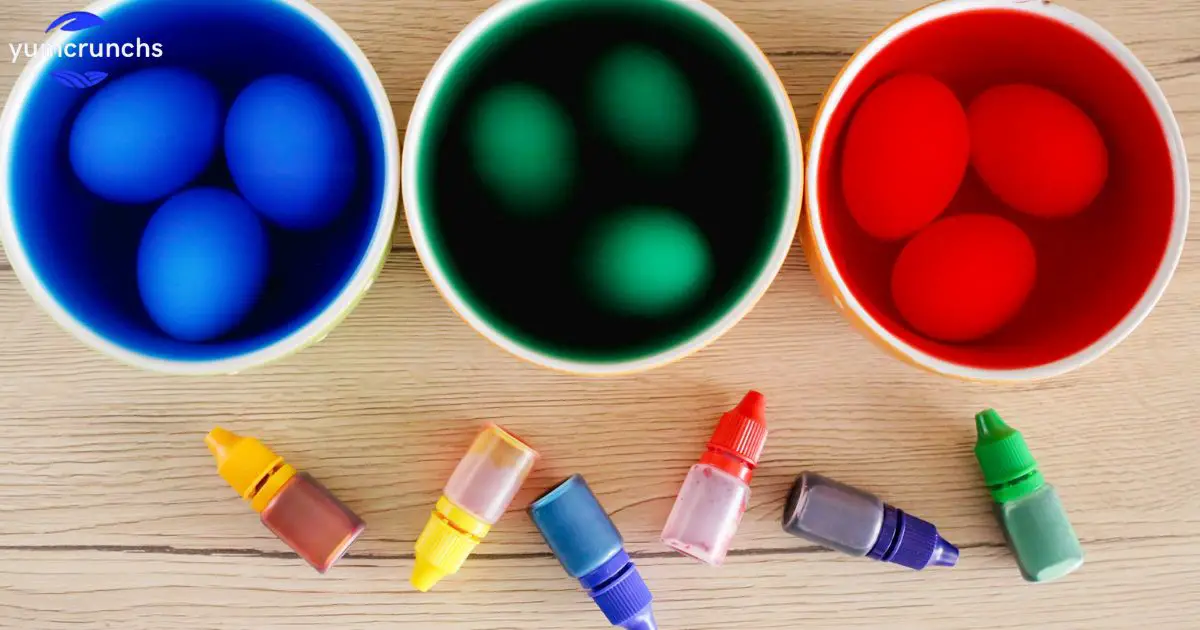Food color refers to substances added to food or beverages to impart or enhance their color. These additives are commonly used in both commercial and homemade cooking to achieve the desired visual appeal in dishes. Whether in liquid, powder, gel, or paste form, food colorants come in a variety of hues and are subject to questions about their shelf life and expiration.
Have you ever wondered, Does food color expire? This question may arise when you’re rummaging through your pantry or kitchen drawers, finding a forgotten bottle of food coloring tucked away. It’s a valid concern, especially considering how long some ingredients can sit unused. Let’s delve into this inquiry to shed some light on the lifespan of food coloring products.
Food color, much like other pantry staples, does indeed have an expiration date. While it may not go “bad” in the same way as perishable items, its quality can degrade over time. Exposure to air, light, and moisture can affect its potency and color vibrancy. Therefore, it’s advisable to check the packaging for expiration dates and store food coloring in a cool, dark place to prolong its shelf life and maintain optimal color intensity.
The Importance of Food Coloring In Culinary Applications
In culinary applications, food coloring plays a vital role. It enhances visual appeal, making dishes more attractive. Different colors signify flavors, aiding in identification and presentation. Chefs use food coloring to create themed or festive dishes.
Food coloring transforms ordinary foods into eye-catching creations. From vibrant cakes to colorful pastries, it adds flair. Its versatility allows for endless creativity in culinary endeavors. With careful use, food coloring elevates both taste and aesthetics.
Common Types Of Food Coloring Available In The Market
In the market, you’ll find various types of food coloring. Liquid food coloring is one common option, convenient for mixing and blending. Gel food coloring offers concentrated hues, ideal for vibrant shades in baking. Powdered food coloring provides intense color and is often used in professional kitchens.
Natural food coloring, derived from plants or minerals, is gaining popularity. These alternatives offer a more natural option for coloring foods. Additionally, oil-based food coloring is suitable for coloring chocolates and candy coatings. Each type offers distinct advantages for culinary use, catering to different needs and preferences.
What Is Food Coloring?

Food coloring is a substance added to foods and beverages to impart or enhance their color. It comes in various forms such as liquids, gels, powders, and pastes. These additives are used in cooking and baking to achieve desired visual effects and make dishes more appealing. Food coloring can range from natural sources like fruits and vegetables to synthetic compounds, offering a wide spectrum of colors to choose from. Its primary function is to enhance the appearance of food, making it more attractive and enticing to consumers.
Definition And Purpose Of Food Coloring
Food coloring is added to food and drinks to change or improve their color. It comes in liquids, gels, powders, and pastes, enhancing visual appeal. Commonly used in cooking and baking, it makes dishes more attractive to consumers. The purpose of food coloring is to create visually appealing culinary creations.
These additives offer a wide range of colors, from natural to synthetic sources. They brighten cakes, cookies, and beverages, adding flair to recipes. Whether it’s a festive red frosting or a vibrant green smoothie, food coloring enhances the appearance of food. How Long Can Betta Fish Go Without Food
Different Forms Of Food Coloring (liquid, Gel, Powder)
Food coloring comes in various forms: liquid, gel, and powder. Liquid food coloring is convenient for mixing and blending into recipes. Gel food coloring offers concentrated hues, ideal for vibrant shades in baking. Powdered food coloring provides intense color and is commonly used in professional kitchens for precise measurements.
Each form of food coloring has its advantages and is suitable for different culinary applications. Liquid food coloring is versatile and easy to incorporate into batters and doughs. Gel food coloring is preferred for creating rich, deep colors without altering the consistency of the mixture. Powdered food coloring is perfect for situations requiring precise color control, such as decorating intricate pastries or confections.
Does Food Coloring Expire?
Yes, food coloring can expire over time. Exposure to air, light, and moisture can affect its potency and color vibrancy. While it may not spoil like perishable items, its quality can degrade. It’s advisable to check the packaging for expiration dates and store food coloring in a cool, dark place to prolong its shelf life.
Understanding The Concept Of Expiration For Food Coloring
Understanding the concept of expiration for food coloring is important. Unlike perishable items, it’s more about quality than safety. Over time, food coloring may lose its potency and vibrancy.
Factors like exposure to air, light, and moisture can speed up this process. While expired food coloring may still be safe, it won’t give vibrant colors. So, it’s wise to check expiration dates before use.
Factors Affecting The Shelf Life Of Food Coloring
Several factors influence the shelf life of food coloring products. Exposure to air, light, and moisture can degrade their quality over time. Proper storage in a cool, dark place can help prolong shelf life.
Additionally, the type of food coloring, whether liquid, gel, or powder, affects its longevity. Liquid food coloring may have a shorter shelf life due to its higher moisture content. Conversely, powdered food coloring tends to last longer. Checking expiration dates and storing properly are essential for maintaining quality.
Signs Of Expired Food Coloring

Signs of expired food coloring are subtle but noticeable. One indication is a change in color intensity or vibrancy. Over time, expired food coloring may lose its potency, resulting in dull or faded colors when used in recipes.
Another sign is a change in texture or consistency. Expired food coloring may become clumpy or develop a gritty texture, indicating degradation. Additionally, an unusual odor may emanate from expired food coloring, signaling that it’s no longer suitable for use in cooking or baking. Can I Eat Food Past Its Expiration Date? Here’s What Experts Say.
If you notice any of these signs, it’s best to discard the expired food coloring and replace it with a fresh product to ensure optimal results in your culinary creations.
Visual Indicators Of Expired Food Coloring
Visual indicators of expired food coloring are crucial for safety. Mold growth signifies spoilage, visible in discolored patches. Liquids may separate, showing inconsistency in texture and color. These signs suggest deterioration and potential health risks.
Additionally, changes in odor signal expiration. A foul smell indicates bacterial growth and contamination. Any deviation from the original appearance or smell warrants disposal. Regularly checking for these visual cues ensures safe consumption.
Changes In Color, Texture, And Odor
Changes in color, texture, and odor are vital indicators of food quality. When food begins to spoil, its color often fades or darkens, indicating deterioration. Texture alterations, such as becoming slimy or mushy, also signal potential spoilage. Moreover, a strange or unpleasant odor suggests bacterial growth and contamination, making the food unsafe to consume. Recognizing these changes can help prevent foodborne illnesses and ensure the freshness of the products we consume.
Regularly inspecting food for these signs is essential for food safety. If you notice any changes in color, texture, or odor, it’s best to discard the item to avoid health risks. By being vigilant and attentive to these indicators, we can make informed decisions about the freshness of our food and protect ourselves from potential harm.
How Long Does Food Coloring Last?
The shelf life of food coloring can vary depending on factors such as its type, storage conditions, and packaging. Generally, liquid food coloring can last for about 2 to 4 years when stored properly in a cool, dry place away from direct sunlight and heat. Gel food coloring typically has a longer shelf life, often lasting up to 5 years or more under the same storage conditions.
Powdered food coloring tends to have the longest shelf life, lasting up to 5 years or even longer if stored correctly. It’s important to check the expiration date on the packaging and discard any food coloring that has passed its expiry date or shows signs of degradation, such as changes in color, texture, or odor. By storing food coloring properly and replacing it when necessary, you can ensure optimal quality and performance in your culinary endeavors.
Estimated Shelf Life Of Different Types Of Food Coloring
The estimated shelf life of different types of food coloring varies depending on their form and storage conditions. Liquid food coloring typically lasts for about 2 to 4 years when stored properly in a cool, dry place away from sunlight and heat. Gel food coloring tends to have a longer shelf life, often lasting up to 5 years or more under similar storage conditions.
Powdered food coloring has the longest shelf life among the different types, lasting up to 5 years or even longer if stored correctly. It’s essential to check the expiration date on the packaging and discard any food coloring that has passed its expiry date or shows signs of degradation, such as changes in color, texture, or odor.
By storing food coloring properly and replacing it when necessary, you can ensure optimal quality and performance in your culinary creations.
Proper Storage Methods To Prolong The Lifespan
Proper storage methods are key to extending the lifespan of products. For food coloring, store in a cool, dry place.
Keep containers tightly sealed to prevent air exposure and deterioration. Avoid storing near heat sources or strong odors. Transfer powdered food coloring to airtight containers for added protection. Following these methods ensures longer-lasting, vibrant colors.
Can Expired Food Coloring Be Used?
Expired food coloring can technically still be used, but its quality may have degraded. While it may not pose any safety risks, using expired food coloring can result in less vibrant colors and potentially alter the taste or texture of your culinary creations. Additionally, expired food coloring may not provide the desired results in terms of color intensity or consistency.
If you choose to use expired food coloring, it’s essential to inspect it carefully for any signs of mold, unusual odors, or changes in texture before incorporating it into your recipes. However, for optimal results, it’s generally recommended to replace expired food coloring with a fresh product to ensure the best quality and performance in your cooking and baking endeavors.
Safety Considerations When Using Expired Food Coloring
Safety considerations when using expired food coloring are paramount. Expired food coloring may contain harmful bacteria or toxins. Consumption can lead to foodborne illnesses and health risks. It’s crucial to discard expired food coloring promptly to prevent any potential harm.
Using expired food coloring can compromise the quality and safety of dishes. Even if expired food coloring appears normal, it may pose health risks. Always prioritize using fresh and unexpired ingredients for cooking and baking.
Impact On Color Intensity And Quality
The impact on color intensity and quality is crucial in food coloring. Expired products may lead to less vibrant colors and uneven tones.
Over time, food coloring loses its potency, resulting in faded hues. This affects the visual appeal and quality of culinary creations.
Using fresh food coloring ensures vibrant colors and top-notch quality. It’s essential for delightful dishes!
Proper Storage Of Food Coloring
Proper storage of food coloring is essential for maintaining its quality. Store it in a cool, dry place away from sunlight and heat sources. Keep containers tightly sealed to prevent air exposure, which can degrade the product.
For liquid food coloring, storing it upright can help prevent leakage and maintain consistency. Avoid storing food coloring near strong-smelling substances to prevent absorption of odors. Additionally, check the expiration date regularly and discard any expired products to ensure optimal results in your culinary endeavors.
Best Practices For Storing Food Coloring

Best practices for storing food coloring ensure longevity and quality. Keep food coloring in a cool, dark place away from sunlight. Seal tightly to prevent air exposure and maintain freshness longer. Avoid storing near strong-smelling items to prevent flavor contamination.
Additionally, check expiration dates regularly to ensure potency and safety. Store liquid food coloring upright to prevent leakage and spills. Following these guidelines will help preserve the quality of your food coloring.
Tips To Prevent Contamination And Maintain Freshness
To prevent contamination and maintain freshness of food coloring, follow these tips. First, seal containers tightly after each use to avoid air exposure. This helps prevent oxidation and deterioration of the coloring.
Second, store food coloring away from strong odors to prevent absorption. Keeping it in a cool, dry place away from sunlight and heat sources also helps maintain its quality. By following these simple practices, you can ensure that your food coloring stays fresh and free from contamination for optimal use in your culinary creations.
Other Factors Influencing Shelf Life
Other factors influencing the shelf life of food coloring include packaging and exposure to moisture. The type of packaging can affect how well the product is protected from air and light, which can impact its longevity.
Additionally, exposure to moisture can cause clumping or mold growth, reducing the shelf life of the product. Proper storage in a dry environment is essential for maintaining the quality of food coloring over time.
Furthermore, the quality of ingredients used in the food coloring can also play a role in its shelf life. High-quality ingredients may result in a longer-lasting product compared to those with lower-quality components. Overall, proper storage and quality ingredients are key factors in determining the shelf life of food coloring.
Effects Of Exposure To Heat, Light, And Air On Food Coloring
Exposure to heat, light, and air can have detrimental effects on food coloring. Heat can accelerate the degradation of colorants, leading to a loss of vibrancy and potency. Additionally, prolonged exposure to light can cause photochemical reactions, resulting in color fading and changes in hue.
Air exposure can also be problematic, as oxygen can oxidize certain compounds in food coloring, causing discoloration and degradation of quality. This can lead to changes in taste, texture, and overall performance in culinary applications.
To preserve the integrity of food coloring, it’s essential to store it in a cool, dark place and keep containers tightly sealed to minimize exposure to heat, light, and air. By taking these precautions, you can prolong the shelf life and maintain the quality of your food coloring for optimal use in your recipes.
Role Of Additives And Preservatives
The role of additives and preservatives is crucial in food coloring. Additives are substances added to enhance color intensity or stability.
Preservatives are added to extend shelf life and prevent spoilage. Both additives and preservatives help maintain the quality and freshness of food coloring products.
They ensure that the colors remain vibrant and consistent over time, even when exposed to various environmental factors. By incorporating these ingredients, manufacturers can offer consumers reliable and long-lasting food coloring options.
Other Factors Influencing Shelf Life
Several factors can influence the shelf life of food coloring, aside from packaging and exposure to moisture. The quality of ingredients used in the manufacturing process plays a significant role. High-quality ingredients tend to result in a longer-lasting product compared to those with lower-quality components.
Storage conditions also play a crucial role in determining shelf life. Storing food coloring in a cool, dry place away from sunlight and heat sources can help prolong its freshness. Additionally, proper sealing of containers and minimizing air exposure can prevent oxidation and degradation of the product.
Furthermore, the presence of any additional stabilizers or antioxidants in the formulation can contribute to extending shelf life by maintaining color stability and preventing deterioration. Overall, various factors, including ingredient quality, storage conditions, and formulation, collectively influence the shelf life of food coloring products.
Effects Of Exposure To Heat, Light, And Air On Food Coloring

Exposure to heat, light, and air can alter food coloring. Heat breaks down colors, changing their appearance and intensity. Light exposure can cause fading and discoloration in food dyes. Additionally, air exposure may lead to oxidation, affecting color stability.
When food coloring is exposed to heat, its molecules become unstable. This instability can cause colors to fade or change. Light exposure can accelerate color degradation in food products. Oxygen in the air can interact with food coloring, leading to color changes. To maintain color quality, store food coloring in cool, dark, airtight containers.
FAQ’s
How does exposure to heat affect food coloring?
Exposure to heat can cause food coloring molecules to become unstable, leading to color fading or changes.
What steps can be taken to preserve the quality of food coloring?
Storing food coloring in cool, dark, airtight containers can help prevent color degradation caused by light, heat, and air exposure.
Conclusion
In conclusion, understanding the factors influencing the shelf life of food coloring is vital. From proper storage methods to the impact of exposure to heat, light, and air, each aspect plays a crucial role in maintaining the quality of these products. By being mindful of these factors, you can ensure that your food coloring remains fresh and vibrant for longer periods.
As you ponder the effects of storage conditions and environmental exposure on food coloring, you may find yourself considering new strategies for preserving its quality. After all, a little extra care can go a long way in enhancing the longevity and performance of these colorful additives.

Daniel, a seasoned author with 8 years of expertise in SEO, brings a delectable blend of culinary flair and digital finesse to the food niche on his website.



